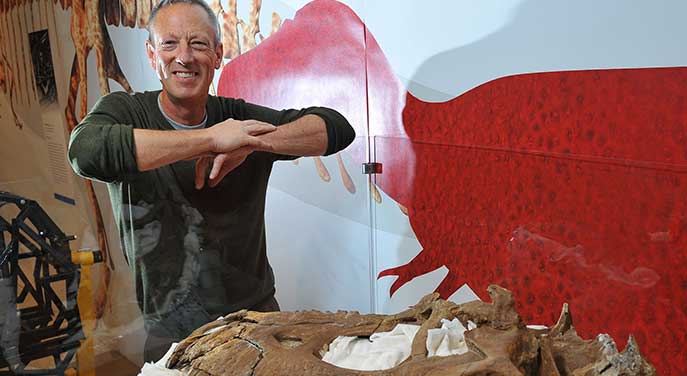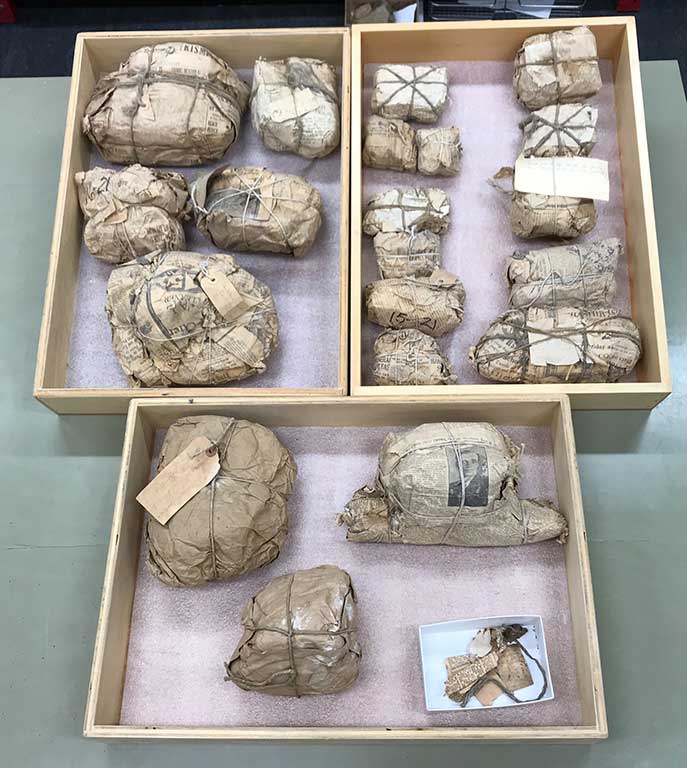
Paleontology researcher Clive Coy says dinosaur bones found wrapped in old newspapers in storage at the U of A are objects of both scientific and historical curiosity.
A stash of rediscovered dinosaur bones wrapped in century-old newspapers is set to reveal two pasts: one set in the 1920s and the University of Alberta’s earliest paleontology, the other some 70 million years ago.
“It’s always a surprise to find these bones that have been sitting in the ground for millions of years, but here we get a second surprise in finding them again,” said Clive Coy, a paleontology researcher in the Faculty of Science.
Handwriting on the specimens suggests the haul is part of the 1920 and 1921 expeditions in what is now Dinosaur Provincial Park, led by the U of A’s first paleontologist, George Sternberg.

A handwritten tag on one of the fossils found wrapped in newspapers suggests it was unearthed during expeditions in the early 1920s.
The 20 or so pieces were pulled from a back shelf in a quonset on the University of Alberta’s South Campus. Ranging in size from an apple to a melon, they’re wrapped up in multiple layers of newspaper and tied up with bailing twine. Based on the labelling, Coy figures the bones were stored in the quonset in the late 1960s or early ’70s.
Coy is particularly interested in one labelled “three turtle skulls from quarry where numbers eight through 18 were collected.”
“Turtle skulls are extremely rare and – considering how old they are and preserved in just newspaper – they could be quite important,” he said.
Coy said dating the bones will be a challenge. When these bones were found 100 years ago, paleontologists of the day worked under the assumption that the Judith River Deposit in southern Alberta and Montana was one big deposit.
We now know the uppermost layer is a marine deposit that came in at the end of the Cretaceous, when that part of the world was flooded by an ocean, said Coy. The turtles are most likely from a time even earlier, from what is known as the Dinosaur Park formation, which existed somewhere between 72 million and 76 million years ago.
While he may unwrap the turtle skull bundle to have a look, Coy said the rest of the specimens have more value as historical artifacts.
“If we unwrap them, like unwrapping a mummy, then we just end up with a bone in a box, and I don’t know that it’s going to add much to our knowledge. But as a part of the U of A’s historical past, that’s where the greater value lies.”

Apart from any scientific value they may have, the rediscovered specimens offer a glimpse into the U of A’s beginnings in paleontology.
Sternberg owes his start at the U of A to John Allan, the university’s first geologist, who had a vision of building a collection of fossil fauna and flora for the people of Alberta.
Until the start of the First World War, the federal and provincial governments chose not to control foreign entities collecting Alberta fossils – which were being sent by rail out of the badlands as fast as they could be dug up as part of the Great Dinosaur Rush from 1910 to 1918.
“There was a time when, if you wanted to see Alberta dinosaurs, you had to go to Stuttgart, Paris, New York or London,” said Coy.
Allan was one of the movers and shakers who encouraged the government to create a provincial museum in the late 1920s. He also lobbied for the protection of Dead Lodge Canyon or the Steveville Badlands, both of which are in the area that became Dinosaur Provincial Park in 1952 and was designated a UNESCO World Heritage Site in 1979.
Sternberg, who was part of a famous American family of fossil hunters, was in Canada during the war years to collect fossils for the Geological Survey of Canada.
To help lure Sternberg to the university, Allan bought a collection that Sternberg himself had freelanced, and hired him in 1919 to prepare that material.
That was a precursor to the famed 1920 and 1921 expeditions led by Sternberg with U of A geology grad student William “Bill” Kelly.
Almost as fast as the university’s fledgling paleontology efforts took flight, they were grounded when Sternberg left for the Chicago Field Museum in 1922. Nothing would be done at the university for Sternberg’s dinosaurs until 1934, when Allan accessed some money from the Carnegie funds to rehire Sternberg and his son to complete what had begun in 1919 – which included founding the university’s Dino Lab.
In 1935, the U of A hosted the first exhibition of dinosaurs in a public institution west of Toronto, on the third floor of the Fine Arts Building. It stood there for two decades until it was moved to the basement of the geology building, home of the Department of Earth and Atmospheric Sciences, where it has rested ever since.
Today, the Sternberg Museum of Natural History at Fort Hays State University in Hays, Kansas, is named for George and his fossil-hunting family. Sternberg’s protege Kelly would become one of the early pioneers in developing aerial photography for economic mineral exploration. Allan stayed as the head of the U of A geology department until his retirement in 1949.
Today the university’s Laboratory for Vertebrate Paleontology is one of 30 registered museum collections on campus and has on the order of 65,000 specimens – among the first of which now sit in Coy’s lab wrapped in newspaper.
“Sternberg and Kelly would have been the last people to see the specimens inside that newspaper in the last 100 years,” said Coy.
“There is historical interest as part of our heritage here at the university, tying in the early story of how we got up and going as the first publicly funded institution in Alberta to do this kind of thing.”
| By Michael Brown
Submitted by the University of Alberta’s Folio online magazine. The University of Alberta is a Troy Media Editorial Content Provider Partner.
© Troy Media
Troy Media is an editorial content provider to media outlets and its own hosted community news outlets across Canada.

